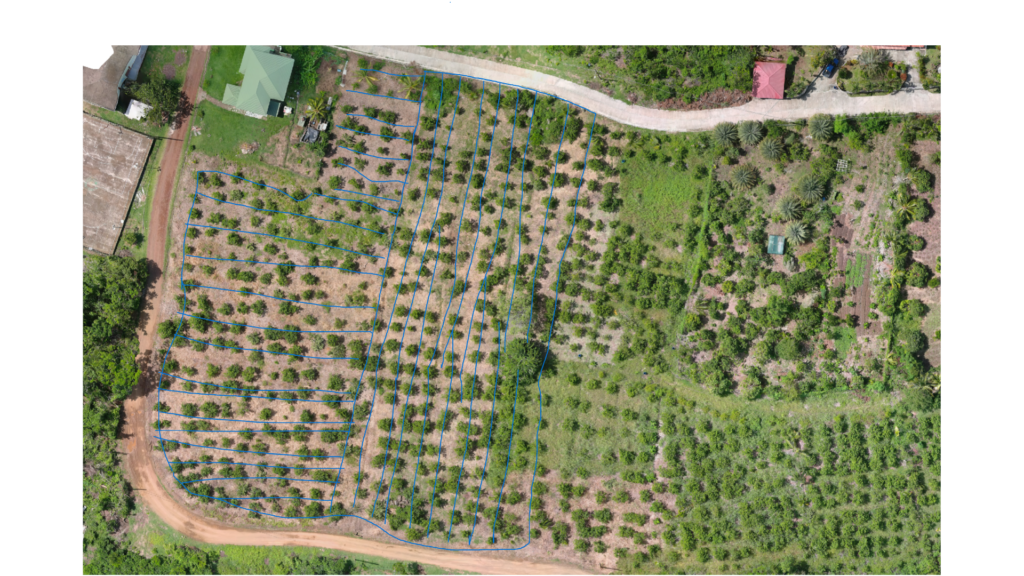DriP Irrigation System design for the upcoming heat and drought period.

The Blue lines are indicating the target plot where the drip systems are to be placed.
We seek to optimize the drip irrigation system for the sour sop trees in the context of a climate adaptation project, here are a few considerations and calculations:
What did we take into consideration for this design?
1. Irrigation Layout and Distance Calculation
Given the plot width of approximately 350 feet across, you might be thinking about how to layout the drip lines effectively:
- Drip Line Spacing: Depending on the maturity of the sour sop trees and their root spread, the spacing between drip lines should ideally match the expected canopy spread at maturity to ensure optimal root zone coverage. Sour sop trees can have a spread of about 20-30 feet at maturity. You might consider placing drip lines every 15-20 feet across the row width to ensure complete soil saturation under the dripline of the trees.
- Length of Drip Lines: The total width of the area (350 feet) will dictate the length of each drip line if they run perpendicular to the road.
2. Irrigation Flow Rate and Dripper Spacing
- Dripper Spacing: The spacing between drippers on the line can be about 0.5 to 1 meter, depending on the soil type and water requirements of the plant. More frequent spacing can be used in sandy soils where water disperses quickly, and wider spacing can be used in clay-rich soils.
- Flow Rate: You’ll need to choose drippers based on their flow rate, which is usually measured in liters per hour (L/h). Sour sop trees in drought-prone areas might require more frequent water but in controlled quantities to encourage deep root growth.
3. Calculating Total Line Length and Dripper Quantity
- Total Line Length: If you plan to lay lines every 15 feet across a 350 feet wide plot, you would have approximately 24 lines (350 / 15 = ~23.3, round to 24). Each line being 350 feet long results in a total of 8,400 feet of drip line (24 lines x 350 feet).
- Dripper Quantity: If you place one dripper per meter (about 3.3 feet), each 350-foot line would have approximately 106 drippers (350 feet / 3.3 feet per dripper). For all 24 lines, this results in approximately 2,544 drippers (24 lines x 106 drippers).
4. Water Supply Requirements
Calculating the total water flow rate required for the entire system will help you size your pump and storage correctly:
- If each dripper emits 2 liters per hour, the total system flow rate would be 5,088 liters per hour (2,544 drippers x 2 L/h).
Recommendations
- System Pressure and Pumping: Ensure the pump can handle the total flow rate at the necessary pressure. Drip systems typically operate at about 10-30 psi.
- Water Storage: Consider water storage capacity that can supply at least a few cycles of irrigation, especially in drought conditions.
- Automation and Controls: Using timers or soil moisture sensors can help in automating the irrigation process, making it more efficient and responsive to the actual needs of the plants.
Here’s a table-format comparison between drip lines and drip tapes for your irrigation system:
| Feature | Drip Lines | Drip Tapes |
|---|---|---|
| Cost | More expensive due to durable materials and features. | Less expensive, cost-effective for large areas. |
| Durability | Highly durable, suitable for long-term use. | Less durable, prone to damage from environmental factors and machinery. |
| Installation | More complex installation, may require professional setup. | Easier and quicker to install, can be adjusted easily. |
| Water Distribution | Often includes pressure-compensating emitters for uniform distribution. | May lack uniform water distribution in uneven terrain without compensating features. |
| Suitability for Perennial Crops | Ideal for perennial crops like sour sop trees due to durability and consistent output. | Less ideal for long-term crops unless replaced periodically. |
| Flexibility | Less flexible, typically used in fixed layouts. | Highly flexible, can be easily laid out around irregular patterns. |
| Longevity | Longer lifespan, can handle higher pressures and more extreme conditions. | Shorter lifespan, more suitable for seasonal or annual crops. |
This comparative analysis should help in deciding which irrigation method fits best with the needs of your sour sop plantation, taking into account factors like cost, durability, and the specific requirements of the trees and terrain.